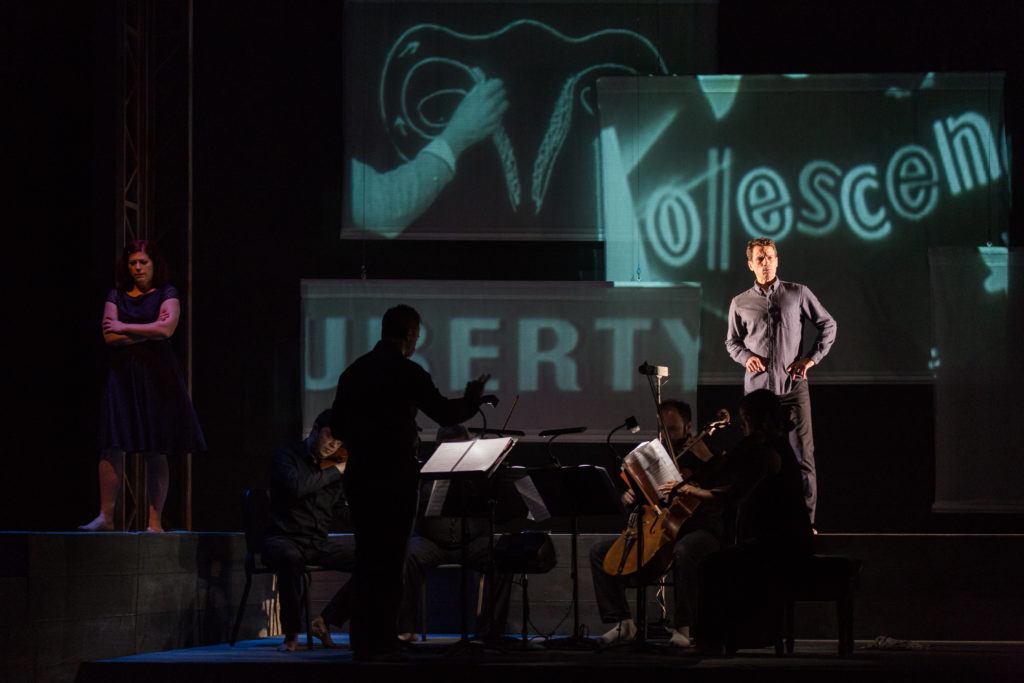Archive for 2017
The transgender experience is lovingly explored in San Diego Opera’s “As One”
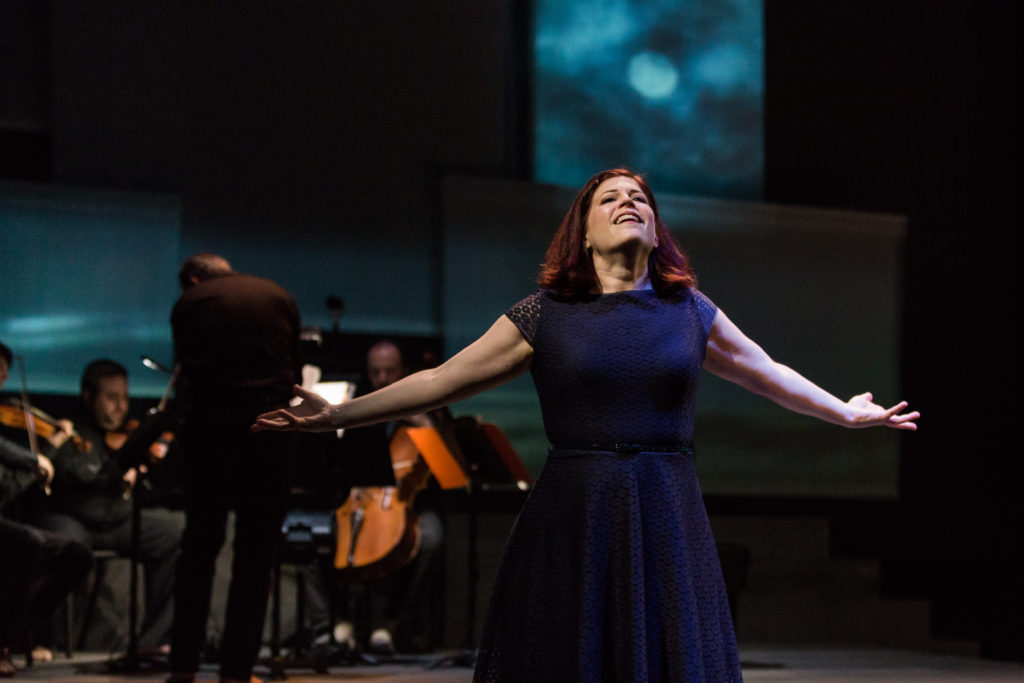
Mezzo-soprano Blythe Gaissert is Hannah After in San Diego Opera’s AS ONE. November, 2017. Photo by Karli Cadel.
As One
Music & Concept by Laura Kaminsky
Libretto by Mark Campbell & Kimberly Reed
Film by Kimberly Reed
Joan B Kroc Theatre
6611 University Ave, San Diego, CA 92115
Review by David Gregson, performance of Friday, November 10
Revised extensively and censored by author, November 16.
Composed by Laura Kaminsky, As One had its world premiere in 2014 at the Brooklyn Academy of Music’s Fisher Space. With its libretto by Mark Campbell and Kimberly Reed (who also created the accompanying video), the piece explores the experiences of transgender individuals who have come the proverbial long way in their search for acceptance on the personal and social level.
As One presents two characters, a baritone and a soprano, who simultaneously represent a single identity. This brings to mind Anna One and Anna Two, the heroine/heroines of Kurt Weill’s, The Seven Deadly Sins, played by Lotte Lenya (Anna I) and Tilly Losch (Anna II) in 1933. In As One, the hero/heroine is named Hannah.
The San Diego cast is superb. Kelly Markgraf is by now a well settled veteran in his role of “Hannah Before,” and he displays a rich, forceful baritone. Mezzo-soprano Blythe Gaissert inhabits “Hannah After” and brings deep emotional conviction vocally and in all her gestures. The two characters are always on the stage, but they are joined by a string quartet (the Hausmann) led by the accomplished conductor, Bruce Stasyna. Five differently sized video screens provide a visual ambiance with images from the film created by Reed. Kyle Lang is the inventive stage director who makes the most out of very little. Supertitles are projected despite the excellent diction of both Markgraf and Gaissert.
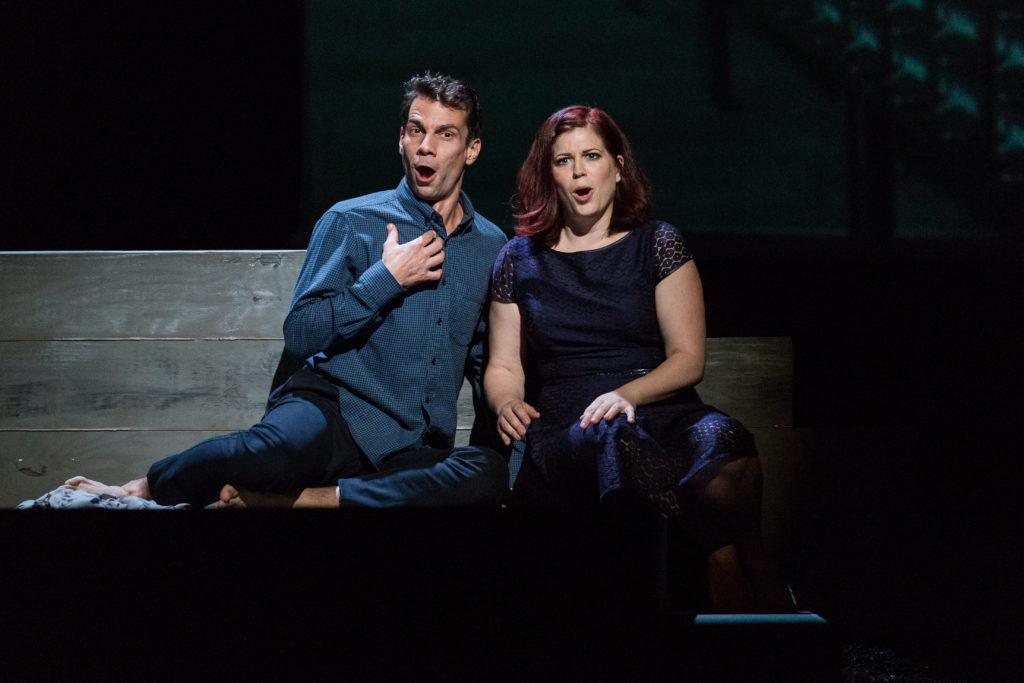
(L-R) Baritone Kelly Markgraf (Hannah Before) and mezzo-soprano Blythe Gaissert (Hannah After) in San Diego Opera’s AS ONE. November, 2017. Photo by Karli Cadel.
So, what’s it all about? Although I have never wanted to change my sex or to wander the streets in drag, Swiss psychoanalyst Carl Jung postulated the existence of an anima and animus in all of us. He defined these as the female and male components of the human psyche. In his metaphoric vision, he saw these, as well as many other elements of a person’s personality (all of which he carefully defined), as seeking “individuation,” an integration of all the disparate elements into a functioning whole.
It would be interesting to hear a practiced Jungian psychologist discuss As One, a work that depicts a transexual’s physical and psychological movement from a man into a woman. The creators of this work have said the story is not of a transition per se because the male and female were always present in the opera’s protagonist (protagonists?) — for indeed, according to Jung, every man has an anima inside and every woman an animus. Director, Kyle Lang, told San Diego Story music writer, Ken Herman, that the opera transcends topicality: “No matter who you are, either you or someone close to you has some part of themselves that is considered less than normative.”
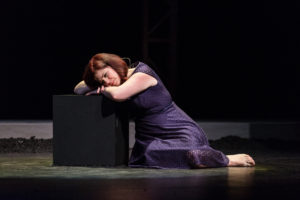
Mezzo-soprano Blythe Gaissert is Hannah After in San Diego Opera’s AS ONE. November, 2017. Photo by Karli Cadel.
As One has been presented here and there around the country least eleven times, which makes it one of the more frequently performed contemporary operas in America. Perhaps this is because As One is a Zeitoper, a quasi-didactic opera with a lesson for our times, but more likely it is because a virtually pre-packaged piece with only two singers and a string quartet is cheaper to produce than Il Trovatore. Opera companies need to cut costs these days, and it’s no secret that San Diego Opera is not even remotely on the cusp of presenting Wagner’s “Ring” cycle. We are being asked to accept As One, part of the SDO 2017-18 dētour Series, as something not so grand, but nonetheless important. I do wonder if those who crave Verdi’s Don Carlo are going to continue to adjust to such reduced expectations.
Whatever the case, As One is a provocative and worthy musical/dramatic offering, and as I have suggested, it deals with a subject both brand new as well “in the news,” but also a subject that has been around forever in various coded forms in our literature and pop entertainments. The Victorian Dr. Jekyll famously had a sexualized Mr. Hyde inside of him, and bidden forth by British Hammer Film productions, out came Sister Hyde in 1971. Greek mythology and theater give us Teiresias, the blind seer who had once been a woman — and the greatest immortal of them all, Pallas Athena, appeared as a man whenever she wished. She was also the God (or Goddess) of War before the Greeks invented Ares (Mars), for which see Robert Graves’ The Greek Myths. Diehard opera fans need not be reminded that the genre is sprinkled with “trouser roles” in which women and countertenors channel their animus to the fore.
The story of As One is fragmented into 15 titled songs, distributed among three distinct parts. For the whole, think Schubert’s “Winterreise” or “Die schöne Müllerin,” only without a single memorable tune you can whistle. The texts are good, but nothing rises to the level of Bertolt Brecht’s poetry employed in various didactic pieces written for Kurt Weill, composer of the aforementioned Seven Deadly Sins.
Sharing the synopsis here seems the most efficient thing to do — with commentary.
Part I: In “Paper Route,” Hannah rides around her suburban neighborhood delivering newspapers and revels in her more feminine impulses. Her youthful challenges in conforming to gender norms are related in songs called “Cursive,” “Sex-Ed,” “Entire of Itself ” and “Perfect Boy” — and in such disparate subjects as handwriting, sex, a John Donne poem, and exemplary male behavior. However, in “To Know,” she discovers that she is not alone in the world and seeks understanding about herself at a local library.
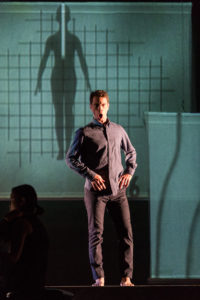
Baritone Kelly Markgraf is Hannah Before in San Diego Opera’s AS ONE. November, 2017. Photo by Karli Cadel.
Hannah wears a blouse under her boy’s shirt. “Cursive” brings up the issue of feminine handwriting, a subject I have never before considered and found interesting. But any gay or straight man can relate to the lame high school sex-ed classes we were offered back in the dark ages. And as for “Perfect Boy” — trying to seem butch is a bit of painful nostalgia for many brave American survivors.
The great 17th-century metaphysical poet John Donne seems to be getting around these days. Playwright Margaret Edison made a superb one-act play, Wit, with Donne at its center. Unforgettable in John Adams’ opera Doctor Atomic is the aria “Batter my heart three-personed God,” and “No man is an island” is a simile that works its way meaningfully through As One.”
“It isn’t true,” Hannah tells her professor at high school. “I am an island / With all the experience / Of my fourteen years, / I see no other life / Than one apart/ Alone.” Much. much later in Norway she thinks, “And here, / On my self-imposed island, / I connect with the universe. / And the universe tells me: / “You are an idiot.”
Part II: During her college years, Hannah struggles with her bifurcated existence in “Two Cities,” but also encounters the joy of being perceived as she wishes in “Three Words.” In “Close,” she has made the decision to undergo hormone therapy and briefly suffers its vertiginous effects before feenturyeling at one with her own body. “Home for the Holidays,” “A Christmas Story” and “Dear Son” all occur around the Christmas season and relate Hannah’s growing distance to her family and her past, which is countered by an immediate connection with a stranger in a local café. In “Out of Nowhere,” Hannah escapes a harrowing assault that prompts her to find a link to the larger trans community and end her self-imposed alienation. Reacting to the conflicting voices in her head, she finally resolves to escape in the fragment, “I Go On To…’”
Some critics have praised the universality of As One — and this section has many moments that resonate. One of the two cities referenced is clearly San Francisco where thousands of gays poured into the Castro District to escape the oppressive homophobia of their dreary home towns and to seek a sense of community. Holidays were often lonely and one had to take refuge in bars, diners and coffee houses — although my own San Francisco experiences in the ‘60s consisted of getting invited to all sorts of interesting places for Thanksgiving and Christmas. Letters from home always spoke of confused or clueless parents. As for violence, one did not need to be trans in order to encounter it in the wrong places at the wrong time. Encountering a bigot in “Out of Nowhere” provides one of the strongest moments in As One.
Part III: “Norway.” In this extended aria, Hannah finds, in Nature, solitude, and self-reflection, the simple yet surprising equation that will help her achieve happiness.”
The baritone is shut out of this final sequence. People I spoke to seemed confused as to whether Hannah had completed her transition before living in Norway or whilst she was there. Being alone in a wonderful place which sometimes disillusions us strikes me as a universal experience — at least for those who can afford to seek exotic locales and time for self confrontation.
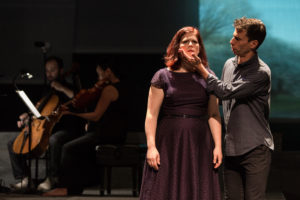
(L-R) Mezzo-soprano Blythe Gaissert (Hannah After) and baritone Kelly Markgraf (Hannah Before) in San Diego Opera’s AS ONE. November, 2017. Photo by Karli Cadel.
The music of As One is effective and suits the drama such as it is, but the vocal lines are declamatory in a style that makes an old opera lover long for a return of lyric melody to the genre. The composer tries to convince us at times by doubling the voice line in the strings. Surely this must be a melody! And yet the vocal lines are well integrated into the string ensemble. As for the latter, things occasionally chug along with inflections from contemporary minimalism. The score is, as they say, accessible — meaning it’s not atonal or academic serialism. Many passages of dissonance occur at moments of dramatic crisis, and in the Christmas scenes display a touch of polytonality as Christmas carols enter the musical proceedings.
I regret having missed the talks which are surely worthwhile. I wanted to write my review in a timely fashion. Also, I am a bit alone on the issue of pre and post-concert discussions — a fact I discovered at the annual Ojai Festival where talk about the music often far, far exceeds the time allotted to the playing of the works themselves. People seem to love this and flock eagerly to be schooled. I have always felt art should speak for itself directly. I recall Tom Wolfe’s amusing prediction in The Painted Word that someday art galleries would hang gigantic art-speak explanations on the wall, with the actual paintings themselves relegated to small reproductions. When the musical lectures and discussions are longer than the music being offered, things have indeed reached a pretty pass.
CAST
Kelly Markgraf — Hannah before
Blythe Gaissert — Hannah after
Kyle Lang — Stage Director
Bruce Stasyna — Conductor
PERFORMANCES
FRI, NOV 10 AT 7PM
SAT, NOV 11 AT 7PM
SUN, NOV 12 AT 1PM

